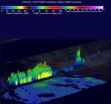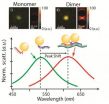Novel compound halts cocaine addiction and relapse behaviors
2014-04-23
(Press-News.org) BUFFALO, N.Y. – A novel compound that targets an important brain receptor has a dramatic effect against a host of cocaine addiction behaviors, including relapse behavior, a University at Buffalo animal study has found.
The research provides strong evidence that this may be a novel lead compound for treating cocaine addiction, for which no effective medications exist.
The UB research was published as an online preview article in Neuropsychopharmacology last week.
In the study, the compound, RO5263397, severely blunted a broad range of cocaine addiction behaviors.
"This is the first systematic study to convincingly show that RO5263397 has the potential to treat cocaine addiction," said Jun-Xu Li, MD, PhD, senior author and assistant professor of pharmacology and toxicology in the UB School of Medicine and Biomedical Sciences. A photo is at http://www.buffalo.edu/news/releases/2014/04/048.html.
"Our research shows that trace amine associated receptor 1 -- TAAR 1-- holds great promise as a novel drug target for the development of novel medications for cocaine addiction," he said.
TAAR 1 is a novel receptor in the brain that is activated by minute amounts of brain chemicals called trace amines.
The findings are especially important, Li added, since despite many years of research, there are no effective medications for treating cocaine addiction.
The compound targets TAAR 1, which is expressed in key drug reward and addiction regions of the brain.
"Because TAAR 1 anatomically and neurochemically is closely related to dopamine -- one of the key molecules in the brain that contributes to cocaine addiction -- and is thought to be a 'brake' on dopamine activity, drugs that stimulate TAAR 1 may be able to counteract cocaine addiction," Li explained.
The UB research tested this hypothesis by using a newly developed TAAR 1 agonist RO5263397, a drug that stimulates TAAR 1 receptors, in animal models of human cocaine abuse.
One of the ways that researchers test the rewarding effects of cocaine in animals is called conditioned place preference. In this type of test, the animal's persistence in returning to, or staying at, a physical location where the drug was given, is interpreted as indicating that the drug has rewarding effects.
In the UB study, RO5263397 dramatically blocked cocaine's rewarding effects.
"When we give the rats RO5263397, they no longer perceive cocaine rewarding, suggesting that the primary effect that drives cocaine addiction in humans has been blunted," said Li.
The compound also markedly blunted cocaine relapse in the animals.
"Cocaine users often stay clean for some time, but may relapse when they re-experience cocaine or hang out in the old cocaine use environments," said Li. "We found that RO5263397 markedly blocked the effect of cocaine or cocaine-related cues for priming relapse behavior.
"Also, when we measured how hard the animals are willing to work to get an injection of cocaine, RO5263397 reduced the animals' motivation to get cocaine," said Li. "This compound makes rats less willing to work for cocaine, which led to decreased cocaine use."
The UB researchers plan to continue studying RO5263397, especially its effectiveness and mechanisms in curbing relapse to cocaine addiction.
INFORMATION:In addition to Li, co-authors are David A. Thorn, a technician and PhD candidate; Li Jing, PhD, postdoctoral fellow, Yanyan Qiu, research scientist, Amy M. Gancarz-Kausch, PhD, postdoctoral fellow, and David M. Dietz, PhD, assistant professor, all of the UB Department of Pharmacology and Toxicology; Chad M. Galuska, PhD, of the College of Charleston; and Yanan Zhang, PhD, of Research Triangle Institute.
The research was funded by the National Institutes of Health.
ELSE PRESS RELEASES FROM THIS DATE:
NASA sees last vestiges of Tropical Depression Jack
2014-04-23
Tropical Cyclone Jack had weakened to a tropical depression when NASA and JAXA's Tropical Rainfall Measuring Mission (TRMM) satellite passed above on April 22, 2014 at 1120 UTC/7:20 a.m. EDT.
At that time, TRMM found that Jack was devoid of almost all rainfall near the tropical cyclone's center. Outside the center was a different story, however. That's where TRMM's precipitation radar instrument found rain falling at a rate of over 130mm/hr (about 5.1 inches) in a band of thunderstorms that stretched from east of Jack's center to the south. Some of the thunderstorms even ...
EARTH Magazine: Faking quakes at full scale
2014-04-23
Alexandria, Va. – On a muggy day in mid-July 2009, a lone seven-story condominium complex northwest of Kobe, Japan, was violently shaken by an earthquake. Onlookers watched the 23-unit, wood-frame tower sway and bounce while, inside the building, furniture toppled and plates clattered to the floor. No one was hurt during the highly localized event and there was only minimal damage, in part because the building's wooden skeleton had been augmented to better resist earthquake shaking, but also because the whole event — from the seismicity to the partially furnished building ...
Some astronauts at risk for cognitive impairment, animal studies suggest
2014-04-23
Johns Hopkins scientists report that rats exposed to high-energy particles, simulating conditions astronauts would face on a long-term deep space mission, show lapses in attention and slower reaction times, even when the radiation exposure is in extremely low dose ranges.
The cognitive impairments — which affected a large subset, but far from all, of the animals — appear to be linked to protein changes in the brain, the scientists say. The findings, if found to hold true in humans, suggest it may be possible to develop a biological marker to predict sensitivity to radiation's ...
Gold nanoparticles help target, quantify breast cancer segments in a living cell
2014-04-23
WEST LAFAYETTE, Ind. - Purdue University researchers have developed a way to detect and measure cancer levels in a living cell by using tiny gold particles with tails of synthetic DNA.
A team led by Joseph Irudayaraj, professor of agricultural and biological engineering, used gold nanoparticles to target and bind to fragments of genetic material known as BRCA1 messenger RNA splice variants, which can indicate the presence and stage of breast cancer. The number of these mRNA splice variants in a cell can be determined by examining the specific signal that light produces ...
Study identifies enzymes that help fix cancer-causing DNA defects
2014-04-23
Purdue University researchers have identified an important enzyme pathway that helps prevent new cells from receiving too many or too few chromosomes, a condition that has been directly linked to cancer and other diseases.
Mark Hall, associate professor of biochemistry, found that near the end of cell division, the enzyme Cdc14 activates Yen1, an enzyme that ensures any breaks in DNA are fully repaired before the parent cell distributes copies of the genome to daughter cells. This process helps safeguard against some of the most devastating genome errors, including the ...
A key to enjoying massive online photo files may be giving up some control
2014-04-23
PITTSBURGH—The ability of individuals to store and instantly access thousands of their photos online has become a commonplace luxury, but the sheer size of these archives can be intimidating. Researchers at Carnegie Mellon University and Microsoft Research Cambridge, UK, have found people might actually enjoy their collections more by giving up a bit of control and learning to wait.
Their 14-month study showed that people reflected more on past events and developed a renewed interest in their online photos when a device called Photobox would randomly print four or five ...
AGU: Odds of storm waters overflowing Manhattan seawall up 20-fold, new study shows
2014-04-23
WASHINGTON, D.C. -- Maximum water levels in New York harbor during major storms have risen by nearly two and a half feet since the mid-1800s, making the chances of water overtopping the Manhattan seawall now at least 20 times greater than they were 170 years ago, according to a new study. Whereas sea-level rise, which is occurring globally, has raised water levels along New York harbor by nearly a foot and a half since the mid-19th century, the research shows that the maximum height of the city's "once-in-10-years" storm tide has grown additionally by almost a foot in that ...
Study finds long-term survival of human neural stem cells transplanted into primate brain
2014-04-23
Putnam Valley, NY. (Apr. 23 2014) – A team of researchers in Korea who transplanted human neural stem cells (hNSCs) into the brains of nonhuman primates and assessed cell survival and differentiation after 22 and 24 months found that the hNSCs had differentiated into neurons at 24 months and did not cause tumors.
The study will be published in a future issue of Cell Transplantation but is currently freely available on-line as an unedited early e-pub at: http://www.ingentaconnect.com/content/cog/ct/pre-prints/content-ct1117Antonucci2.
The hNSCs were labeled with magnetic ...
Scientists identify source of mysterious sound in the Southern Ocean
2014-04-23
Scientists have conclusive evidence that the source of a unique rhythmic sound, recorded for decades in the Southern Ocean and called the "bio-duck," is the Antarctic minke whale (Balaenoptera bonaerensis). First described and named by submarine personnel in the 1960s who thought it sounded like a duck, the bio-duck sound has been recorded at various locations in the Southern Ocean, but its source has remained a mystery, until now.
In February 2013, an international team of researchers deployed acoustic tags on two Antarctic minke whales in Wilhelmina Bay off the western ...
Autologous stem cell therapy improves motor function in chronic stroke victims
2014-04-23
Putnam Valley, NY. (Apr. 23, 2014) – People who have had a stroke, often suffer motor deficits with little potential to restore neurological function. However, a study conducted in Taiwan, that will be published in a future issue of Cell Transplantation, but is currently freely available on-line as an unedited early e-pub at: http://www.ingentaconnect.com/content/cog/ct/pre-prints/content-ct1168Chen, has found that when one group of stroke victims had their own peripheral blood stem cells (PBSCs) injected directly into the brain and a similar group did not, those who received ...




